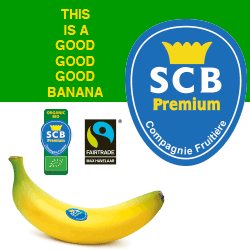World banana market
- Published on 7/05/2015 - Published by LOEILLET Denis
- Free
Currency parity having an effect
The phenomenon has been wished into becoming a major force. Unsurprisingly, it is the subject of discussions at both bar counters and bank counters. There are the believers who think that it will change things, there are the sceptics who see it as nothing more than a fleeting trend, and there are the cautious who are analysing and devising plans… The event does not leave anyone indifferent. As you will all have recognised, this subject on everyone’s lips is the drastic and ongoing fall in euro/dollar parity.
Summary
- A little lesson in complexity…
- Beware the reversibility of the phenomena
- Price increases: obscuring the big picture
- A very convenient expiatory victim: customs duty
- Very limited exchange rate coverage
- Forecasts: betting now open
- Distribution: a victim of its own policy
- A contract only counts if it is adhered to
- A permanent imbalance to whose benefit?
First, let’s reiterate the facts. The euro has come undone against the US dollar, losing a quarter of its value between May 2014 (high point 1.3923 on 8 May) and March 2015 (low point 1.0493 on 16 March). This of course has caused a massive shockwave in the banana sector (18 million tonnes), focused entirely as it is on the international market. For a country like Ecuador, the world’s number one banana supplier, whose economy has been dollarized since 2000, there has been a clear and massive impact. Potentially, the revenue from its sales on the euro markets has been devalued in proportion to the fall in the European currency against the dollar. For each euro sold, an operator now receives just 1.08 USD (mid-April), as opposed to nearly 1.40 USD one year previously. Conversely, invoicing in dollars, e.g. when they sell to the United States, enables them to automatically increase their purchasing power in terms of goods invoiced in euros. That is the theory anyway; now let’s look at the practice, since transactions on the international market are not as simple as that.
A little lesson in complexity…
As we can clearly see in the Ecuadorian example, talking about the exchange rate is never easy. Yet in the case of Ecuador, we might assume it is relatively simple, at least on the surface. As we remarked, its economy is dollarized. The analysis becomes much more complex if we take into account the situation of the other world suppliers, whether they are in the economic sphere of the dollar (Colombia, Costa Rica, Panama, Guatemala, etc.) or the euro (Cameroon, Côte d’Ivoire, etc.). At this point we add an element to the equation, already difficult enough to understand, which is the national currency of the exporting country, and of course its relative variation against the euro and US dollar; since we must refrain from taking shortcuts in this type of matter. The proof of this is that while the fall in the euro is not to the liking of Costa Rica (or Ecuador), it is a godsend for Colombia, and even more so for Ghana. For these countries, the revenue drawn from sales of their bananas in the Eurozone has increased automatically thanks to the fall in the euro.
Confused enough as it is, the situation is further muddied if go into detail, wherein the devil lies hidden. Since the demonstration above only applies if the cost structure of the industry in question is 100 % dependent on the local currency (the peso for Colombia), and if the Colombian operators invoice in euros for all their merchandise sold in Europe.
Taking into account that these two conditions are practically never met, we gain a better understanding that this type of approximation distorts the reading of the effects of exchange rate variation. Since to put it simplistically, a box of bananas ultimately represents just a few kilograms of carbohydrates and a few hundred grams of cardboard and plastic produced from oil. Producing a kilo of bananas, and transporting to the other side of the globe, is just a matter of transporting a few litres of processed oil and water. By which we mean that in the cost structure of a kilo of Colombian or Ghanaian bananas, a very small proportion is dependent on the peso or cedi, and a much larger proportion is dependent on the US dollar. Ditto for Côte d’Ivoire or Cameroon, although these two economies are under the influence of the euro, via use of the CFA franc. Since most of their costs are actually dollarized, primarily energy, transport, amendments or supplies of all kinds.
This takes us to the core of globalisation, indeed the banana is one of its most effective indicators. What we can say is that at least industry employee wage and welfare costs in the country (agricultural labourers, road hauliers, dockers, etc.) are expenses expressed in the national currency. Yet this is not the case with all wages - a large part of the top-level management are most often paid in dollars or euros. The status of agricultural inputs or supplies (cardboard or plastic, for example) varies between countries and their level of development. We might imagine, for example, that a prosperous and highly diversified economy, such as Colombia, would create more added value locally than an economy which imports a large part of its intermediate consumption. Yet outsourcing certain costs abroad through tax optimisation avoids taxation in the country of origin, a practice that the general public is now discovering, but which is the norm worldwide in many sectors, and has been for decades.
Beware the reversibility of the phenomena
So it is hard to have a clear view of the gains or losses in competitiveness associated with the abrupt variation in exchange rates. The graph below is an attempt to clarify the debate. It illustrates the variation of the exchange rate of the US dollar in national currency, between February 2014 and February 2015, for the main suppliers to the US and EU markets. The size of the bubbles is proportional to the import market share of each source in 2014 (excluding Community production). We are working on the condition of “all other things being equal”, assuming that the sale price and production cost were stable between these two dates. This is clearly not the case, but this condition enables us to isolate for analysis purposes the effect of certain variables, while fixing others. In this case currency parity is isolated from the other variations. Finally, for simplification purposes and for the EU alone, only the euro will be factored into our analyses, which is simplistic because other currencies, particularly the pound sterling, are behaving differently against the dollar.
For the United States, we can clearly see Colombia emerging as the big winning source from the changes in currency parity. At constant scope in terms of volume, its revenue increased by 17 % in one year. On the other side of the board, Guatemala (market share 36 %) saw its revenue slump by 2 %. Its currency, the quetzal, appreciated against the US dollar. Besides Guatemala, which lost out, and Ecuador which stabilised its revenue due to the dollarization of its economy, all the other sources benefitted from the depreciation of their currencies against the dollar.
The situation is exactly the reverse for Eurozone suppliers. If we assume that the merchandise arriving in the EU-28 is invoiced entirely in euros (a rough hypothesis to say the least, as explained above), practically all the sources saw their revenue in national currency fall, sometimes even in severe proportions. The most affected were Ecuador, Guatemala, Panama, Belize and Surinam, with a 13 to 18 % loss in competitiveness due to the exchange rate. The Dominican Republic or Costa Rica are not much better off, with a potential loss of 13 and 12 % respectively. The West African sources (Cameroon and Côte d’Ivoire), whose national currency is the CFA franc, in parity with the euro, of course did not see any variation in revenue. Conversely, Ghana earned 15 % more in local currency, the new cedi. Once again, these are potential gains and losses, and are very heavily dependent on the dollar content of their exports and on the currency in which the sale contracts are expressed.
The fact remains that this analysis demonstrates the powerful effects of the changes in exchange rate on the relative competitiveness of sources, in the knowledge that these changes may be sudden, within a matter of only months. Hence we must bear in mind that the phenomenon is reversible. And finally, on a serious note, the analysis must focus closely on the cost structures, and not be conducted on a case-by-case basis. In short, the law is a long way from holding that when the euro weakens, all the sources see their costs increase proportionately.
Price increases: obscuring the big picture
This period of great variation in euro/dollar parity had a major consequence on the market price level, especially in Europe. Since the start of the year, the price has increased steeply, even accelerating in early April. The CIRAD barometer, which evaluates the green banana price in the EU-28, exceeded the 16 euros/box mark in week 13. We need to go back to 2012 to see rates reach such levels at this time of year. The other highlight that sticks in the memory is the rise in the notorious Aldi contracts, one of the biggest German discount supermarkets. These contracts set the tempo for the European green banana market. After weeks of conjecture, they have reportedly been increased by at least 1.5 euro per box, thereby raising the contract price to between 15.25 and 15.75 euros/box, i.e. an average increase of 13 %. Yet, and this is doubtless the outstanding point in the matter, Aldi apparently fixed its prices until the end of 2015, instead of the usual 3 to 4 months! This is unprecedented since the German discounter became the market benchmark. It sends a loud and clear signal: a big distributor has made a 9-month advance commitment, and what is more, to a steeply rising price. Now that we are past the surprise, let’s go back to the basics and check that the increase, though substantial, does at least cover the increased costs due to the collapse of the euro on the exchange market. Well, after the wonderful surprise comes a great depression! Since the inescapable conclusion is that between April 2014 and April 2015, the “Aldi” price did increase by around 7 % in euros, but dropped 15 % in dollars.
We would expect the cost price to decrease proportionately, thanks in particular to the falling energy prices. Yet once more we fall into the inextricable tangle of the exchange markets and commodities markets such as oil, and of the time required for a fall in oil price to be passed onto the price of inputs manufactured from oil. What we can be sure of is that the oil price is falling more rapidly in US dollars than in euros, and much quicker than the euro against the dollar. According to IFPEN, in early 2015 (16 February), the price of oil (Brent) was 50.6 USD/b and 43.9 euros/b, i.e. down 49 and 41 % respectively from 2014. Over the same period, the euro (at 1.15 USD) lost only 13 %. So we should logically see a steep fall in the cost price of the banana. Unless we consider that the transporters and manufacturers of fertilisers, plastics, boxes, phytopharmaceutical products, etc. are taking their time in revising the sale price of their products and services downward. Indeed, many of them could be taking advantage of their oligopolistic, or even monopolistic, position to slow down or eliminate the effect of this major competitiveness lever.
A very convenient expiatory victim: customs duty
So the equation, though complex, is set up: is the value gain in import prices into Europe sufficient to offset the fall in revenue of the intermediate links? Does the big decrease in energy prices affect the cost price of the product, and if so, which link benefits from this redistribution? We are eagerly awaiting the revision of the minimum price in Ecuador, to see which way the coin will fall. If the minimum price falls, the authorities will have to make their arguments properly, and avoid taking refuge behind the detail obscuring the big picture: the tumbling euro. Since although the fall in the euro is having some effect, it is also driving spot import prices into the USA upward, which will eventually have positive effects on the contract prices. The more value there is downstream and the further energy costs fall, the more wealth there is to redistribute at the production stage. Especially since the EU customs duty cost expressed in euros is falling in dollars. This argument, always put forward by Ecuadorian exporters, no longer has any foundation. Furthermore, the planned decreases in customs duty, plus in the case of Ecuador becoming part of a much more favourable customs regime (by the end of 2016?), are reinforcing the current benefits of the exchange rate.
Very limited exchange rate coverage
It is stating the obvious to say that the exchange rate volatility for the past year has had a huge effect on the commercial positioning of companies, and ultimately on their profits. None of them can neglect a financial parameter which has varied by 10, 15 or 25 % in a matter of months. For decades, there have been tools to guard against exchange rate risks. FOREX, the platform on which long-term currency market operations are performed, is a tool able to very largely eliminate these exchange rate effects. Currencies are bought and sold long term, depending on the commercial requirements. Big companies are able to manage their risks via these tools. Small or medium-sized companies do not make much routine use these instruments, and if they do it is often for one-off purposes. According to the information gathered, while many reduced their risks in the first months of the US dollar’s rise, very few now have sufficient exchange coverage. So the parity effect could be challenging for many companies in the sector.
Forecasts: betting now open
As Pierre Dac the famous French humourist said, forecasting is a difficult game, especially when it relates to the future. This applies to some extent to the changes in exchange rates or the price of a barrel of oil. However, we can offer the reader the consensus emerging from all the analysts. Most think that the currencies will continue to lose ground against the US dollar. The FED is further postponing the rise in US interest rates, though this is to give itself a bigger run-up. And even a modest increase in rates will push the dollar to new heights. The quantitative easing policy conducted by the ECB is also having the effect of keeping the euro under pressure. Remember that there is still some margin on its fall: the euro fell to 0.83 in October 2000. On the oil side, the forecast is a bit more uncertain due to the possible effect of the regional conflicts. Nonetheless, we can say that the consensus is settling around a Brent price of 65 USD/b for 2015, and of 70 USD/b for 2016 and 2017.
Distribution: a victim of its own policy
On the distribution side, although different, the situation is just as exciting. Here, the euro/dollar parity, energy prices, US/EU trade-offs and customs duty no longer apply, since in-store, Eurozone customers pay in euros and are not covered on the long-term markets. They are purchasing bananas as never before (+ 546 000 tonnes in two years), in a movement which could well be a major trend. The crisis, which reduced the household purchasing power, and the European distribution sector, which offers highly attractive prices in absolute value, but also relative value in comparison to other fruits on the shelves, created this virtuous bubble of consumption. The consumers became hooked, and in turn they have hooked the distributors, sending non-contract market prices soaring (non-contract graphs).
Large volumes are required. Prices take off as soon as the supply takes on any significance, for classic reasons to do with climate vagaries or for extra-market factors, such as abrupt changes in currency parity. In 2015 (January and February), the very first supply figures for the European market (- 2 %) and US market (- 4 %) confirm that these markets are shrinking slightly, not due to dwindling demand, but to a slightly smaller supply. If we add to this a hesitant start to the seasonal fruit campaigns, it becomes clear that the supermarket sector is in some way a victim of its aggressive positioning policy for the banana supply on its shelves. Has the European supermarket sector become the junkie of the banana dealers? Not really, since the trade is neither fair nor honest, despite what the labels tend to make us believe. Importers and the furthest upstream links in the industry often define themselves as hostages, and they are a long way from developing a Stockholm syndrome toward their kidnapper, the supermarket sector, whose negotiating power is increasingly concentrated and powerful.
A contract only counts if it is adhered to
While the upstream end for now holds all the cards, we cannot rule out turnarounds in the situation; indeed they are certain to come! It remains to be seen how much time it will take. Power has, in part, changed hands. However, the situations are fluid and the balances precarious. A little more fruit, a slightly less intense El Niño, two fewer tornadoes, a persistent, nearly incongruous Harmattan in West Africa, an abundance of competing fruits, etc., and control of the market will switch sides. The distribution sector is setting slightly lower margins and certain upstream links in the industry are setting them much higher (distribution margin graph). That is the law of the market, and particularly the perishable products market. And that is fine! Supporters of a fully contractualised market, where prices and volumes would be determined in a single annual negotiation, definitely need to question their strategy. Spot or contract: both options are on the table. Choosing one or the other is a wager on the future, but one which depends just as heavily on the procurement and cost structure of each company. An operator with high fixed costs, plantations and ships to run, will prefer to manage their own business sensibly. They will not maximise their gains, but will seek to ensure a sufficient and comfortable margin.
An intermediate, lighter in terms of capital and more focused on the downstream part of the sector, will have a natural tendency to take risks, because that is their job, even if it means losing sometimes. They will wager that the gains will always be greater than the losses. They will also observe that contracts are not always adhered to. Indeed, the imbalance in negotiating powers, always in favour of the downstream segment, in many cases weakens the terms of trade. This is not universally true, but it is something to take into account. In certain countries, entering into a contract appears to equate to setting an unbreakable glass ceiling in the event of a buoyant market. In fact, the renegotiating power of a supplier is virtually zero against a big distribution chain. Conversely, if the market came undone, a downward revision would potentially be within the distributor’s power, by adjusting the guaranteed prices or volumes. The debate is not settled, but remains open, especially during these periods of great price variations. Furthermore, we may be shocked at seeing Aldi commit to a relatively high price and over such a long period. The ability to adhere to commitments when the market doubtless comes undone in spring 2015 will turn the contractualisation growth trend one way or another. FruiTrop will of course come back to this subject in the coming months.
A permanent imbalance to whose benefit?
How should we conclude this article, having set out in search of the devil in the details and to show that things are much more complex than appearances would have us believe? Inveterate optimists might retain only the good news: consumption is increasing strongly, in a background trend, and retail prices remain appealing despite steeply rising import prices, etc. They might also believe that the situation is inalterable, that the market has reached a near-perfect equilibrium. In gambling theory, this type of perfect equilibrium, known as a Nash equilibrium, means that none of the players (in this case the distributors and their suppliers) has an interest in going it alone in deviating from the equilibrium achieved, which in the case of the banana, might seem optimum for all at the time. In other words, there is a perfect equilibrium if an economic player does not regret the choice they have made, after seeing the choices made by the others. Anticipation is self-fulfilling, and each player holds their position, favouring a sort of common good.
And this is the chink in the armour. The world banana market is being shaken by countless shocks, both internal and external, which are completely unforeseeable. In short, the information is incomplete since it is necessarily asymmetric between the players, and above all the future is uncertain both in terms of supply and demand. Finally, we know only one thing about the certainties of today: they are highly fleeting. The players constantly regret their choices, and are continually seeking to fine-tune or change their strategy. And we need to recognise that not all commercial strategies are designed under the seal of strict rationality, or in any case that they do not all contribute to an ideal at a given time. In addition to no-one knowing what the banana ideal is, irrationality is in any case part of the DNA of commercial operators. Furthermore, they are not all there, to put it mildly, to manage an income, but to do better, much better, or vastly better than their competitor, no matter whether that is on the back of their supplier or their customer. They know that the wheel turns, and that at one time or another the joke will be on them. So the strategy of the players on this market is in permanent imbalance. The banana economy, just like any other sector, tilts around an equilibrium point. There are forces tending to move the system from its equilibrium point (crudely speaking the vagaries) and forces which tend to restore the system to equilibrium. In this model, contractualisation is one of these forces which ultimately seeks to reduce the uncertainty. The big question is, to whose benefit?





































